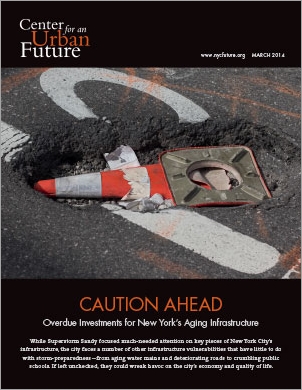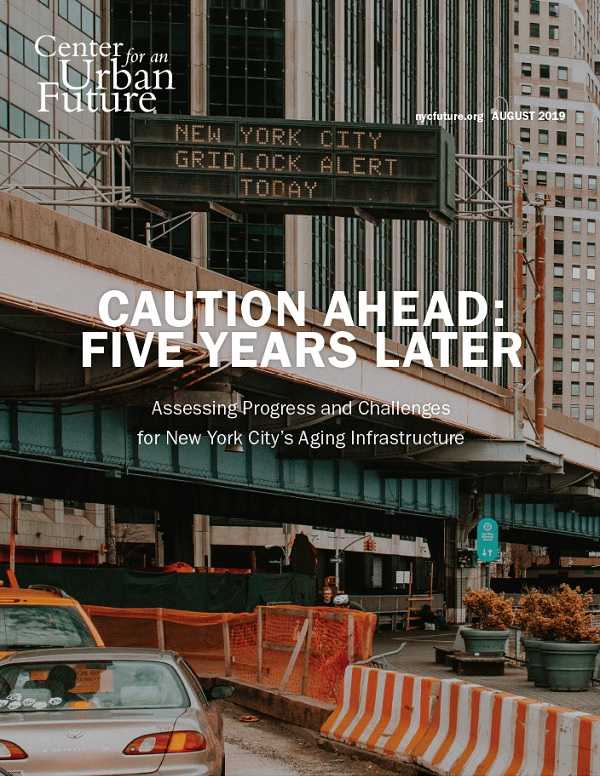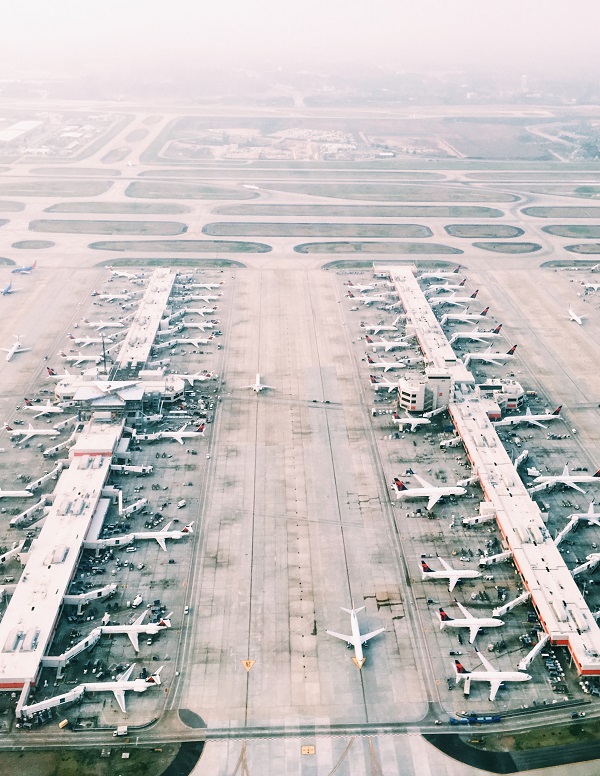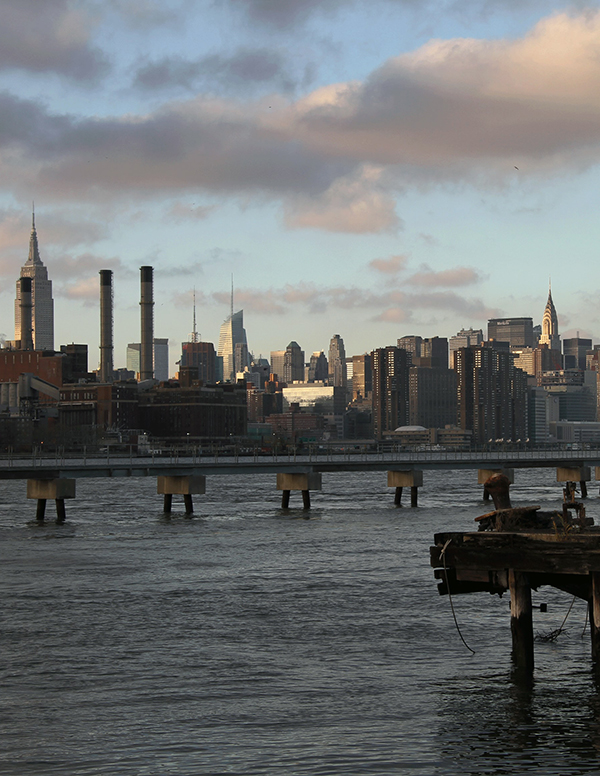The following are the introduction and recommendations to Caution Ahead.
Click here to read the full report (PDF).
Following the devastation of Superstorm Sandy in October 2012, New York City’s essential infrastructure needs were made a top policy priority for the first time in decades. The scale and severity of the storm prompted numerous studies to assess the damage and led policymakers to take steps to shore up the city’s coastal infrastructure weaknesses. Although that work remains imperative, New York City faces a number of other infrastructure vulnerabilities that have little to do with storm preparedness or resiliency. If left unchecked, they could wreak as much havoc on the city’s economy, competitiveness and quality of life as the next big storm.
New York City’s core infrastructure is in dramatically better shape than it was in the 1980s, when the city closed the Williamsburg Bridge for fear of collapse, track fires were a regular occurrence in the subway system and the Brooklyn Bridge, FDR Drive and West Side Highway all experienced structural failures. Yet, as we detail in this report, much of the city’s roads, bridges, subways, water mains, sewer systems, school buildings and other public buildings are more than 50 years old, and many critical components are past their useful life and highly susceptible to breaks and malfunctions.
Over 1,000 miles of New York City water mains are more than 100 years old, leading to frequent and disruptive breaks. More than 160 bridges across the five boroughs were built over a century ago, and in 2012 47 bridges were deemed both structurally deficient and fracture critical, a designation engineers use for bridges that have little structural redundancy, making them prone to failure and collapse. The subway’s aging signaling system—with 269 miles of mainline signals exceeding their 50-year useful life—slows the movement of trains and forces maintenance workers to build their own replacement parts because manufacturers no longer make them. Additionally, more than 200 of the city’s public school buildings were built before 1920.
Simply put, too much of the city’s essential infrastructure remains stuck in the 20th Century—a problem for a city positioning itself to compete with other global cities in today’s 21st Century economy.
While the Bloomberg administration increased capital spending significantly and made great strides on a number of important fronts, it put more emphasis on new construction than bringing older assets into a state of good repair. The city Department of Transportation (DOT) fell behind on street repaving, for instance, while the Department of Environmental Protection (DEP) lost ground on its own water main replacement targets—even as the city funded the first new water tunnel in nearly a century. Although the School Construction Authority dramatically increased the number of public school seats, the maintenance and repair of many older buildings suffered during this period.
This report finds that city agencies and authorities will have to invest approximately $47.3 billion to maintain the safety and functioning of New York’s infrastructure—leaving a $34.2 billion capital funding gap at the city, Port Authority, New York City Transit, Housing Authority and CUNY over the next five years. This funding gap includes only the replacement and repair of existing infrastructure—not new structures or increased capacity.
To remain a magnet for global businesses and talent, and to ensure the high quality of life current residents have come to expect, Mayor Bill de Blasio, Governor Andrew Cuomo and other government officials will need to make investing in the city’s aging infrastructure a major priority. Although it will not be easy in an era of diminished federal funds, this report outlines several achievable solutions for addressing New York’s critical infrastructure needs.
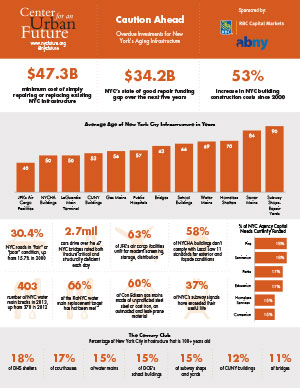
This report provides a comprehensive examination of New York City’s current infrastructure vulnerabilities. It goes beyond the coastal infrastructure challenges that were exposed after Super Storm Sandy and offers a new level of detail about the current state of the city’s infrastructure in a broad range of critical—but often neglected—areas, including roads and bridges, subways, airports, the electricity distribution system, natural gas service pipes, water mains, sewage pipes and the broadband network. Additionally, the report takes a close look at the state of New York’s civic infrastructure, including parks, schools, homeless shelters, CUNY facilities, public hospitals, libraries, public housing and courthouses. Based on extensive data analysis and interviews with more than 100 infrastructure experts in New York and around the nation, the report also puts forth a number of recommendations on what city and state officials can do to address the infrastructure deficiencies outlined in the report.
“In some cases, the infrastructure in New York is so old we don’t even know where it is under the street"
Much of New York City’s skeletal infrastructure dates from the first part of the 20th century. As a result, many structures have been in continual service for over half a century. The average age of New York City’s 6,400 miles of sewage mains is approximately 84 years, for example. Its 6,800 miles of water mains are approximately 69 years old, and its 6,300 miles of gas mains are 56 years old. Over 41 percent of city bridges were built before 1950.
“In some cases, the infrastructure in New York is so old we don’t even know where it is under the street,” notes city planner and historian Alexander Garvin. “There can be a water main break in lower Manhattan and our engineers won’t be able to find it.”
Many of the city’s gas, steam, sewer and water lines are made of old and outmoded materials like unlined cast iron, making them highly susceptible to leaks and breaks. Largely because of leaks, over 2 percent of the gas Con Edison sends to customers every year never makes it to its final destination. The difference between the amount of water that enters the city’s water delivery system and the amount consumed by customers is a staggering 24 percent, about double the 10 to 15 percent industry standard.
Since 1998, New York has experienced at least 400 water main breaks in all but one year; in 2013, there were 403. Although most of the breaks are minor, serious ruptures are an annual occurrence. Already this year, a major water main break on 13th Street in Manhattan flooded the street and nearby subways. (In 2013, a similar incident paralyzed the subways at 23rd Street in south Midtown and, in 2012, a major break occurred near Penn Station.)
“We’re probably going to see more water mains that burst because of fatigue cracks,” notes Sam Schwartz, a renowned transportation engineer and former New York City traffic commissioner.
The city’s 1,445 bridges and 19,000 lane miles of roads and highways also concern engineers. Eleven percent of New York City bridges—162 in all—have been deemed structurally deficient, and 47 bridges have been found to be both structurally deficient and fracture critical. The bridges in this latter category not only suffer from significant distress, they lack sufficient redundancy to withstand that distress. According to engineers, if a single span, beam or joint of such a bridge fails, the whole thing could come tumbling down.
Meanwhile, the city DOT has deemed 30.4 percent of the city’s roads to be in “fair” or “poor” condition, up from 15.7 percent in 2000. Roughly 43 percent of all roads in Manhattan are considered substandard, followed by Staten Island (40 percent), the Bronx (34 percent), Queens (31 percent) and Brooklyn (28 percent). This is cause for concern: The longer the pavement goes without rehabilitation, the faster it begins to deteriorate and the more costly it becomes to fix.
“Arguably city streets are in the worst shape of any of our transportation infrastructure—and that says a lot.” says Elliot Sander, former executive director of the Metropolitan Transportation Authority (MTA) and current president and CEO of the HAKS Group, a construction management firm. “While a lot of resurfacing our streets has been done, they need to be fully reconstructed on a much wider scale, rather than just having asphalt poured on top as a patch. The resurfacing program is helpful, but it is basically an overused Band-Aid, which anyone who uses the city’s streets can attest to.”
The city’s transit infrastructure has undoubtedly come a long way since the 1980s when subways broke down at a much higher rate than they do now, but the MTA’s 659 track miles of subway demand substantial attention, particularly with antiquated subway stations and outmoded signals that regulate the movement and spacing of trains. Of the system’s 728 miles of mainline signals, 269 have exceeded their 50-year useful life and 26 percent are more than 70 years old.
With over 2,600 buildings bigger than 10,000 square feet, New York City is one of the largest landlords in the world. And as with the city’s horizontal infrastructure, a large percentage of these buildings suffer from old age and serious physical defects. For example, with over 370 of the city’s 1,200 public school buildings predating the Great Depression, temperamental heating and cooling systems, leaky roofs, and broken elevators are common. Citywide, 36 different building exteriors, 4 electrical systems and 69 mechanical systems are in need of immediate preventative maintenance.
Similarly daunting capital challenges exist at many of the city’s 24 CUNY campuses, where the average building is 52 years old.
NYCHA’s physical needs were in the spotlight in the wake of Super Storm Sandy when tens of thousands of residents spent weeks without heat or running water. But NYCHA’s problems go beyond storm resiliency. With an average age of nearly 50 years and a long history of underfunding, the majority of the authority’s 2,600 buildings suffer from serious physical distress. A staggering 1,500 or 58 percent do not comply with the Department of Building’s façade standards, as detailed in Local Law 11. Extreme temperatures, collapsed ceilings and persistent mold have left nearly 800 units vacant and uninhabitable—and 319 of these have been empty for over seven years.
In addition, the average public hospital in the city is 57 years old, over half of the clinics operated by the city’s Department of Health and Mental Hygiene were built before 1950, 61 percent of city-owned courthouses were constructed prior to 1940, and the 55 shelters operated by the city’s Department of Homeless Services are more than 70 years old, on average.

